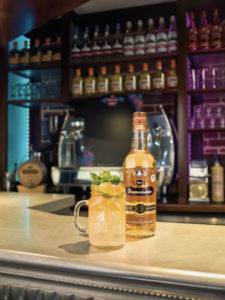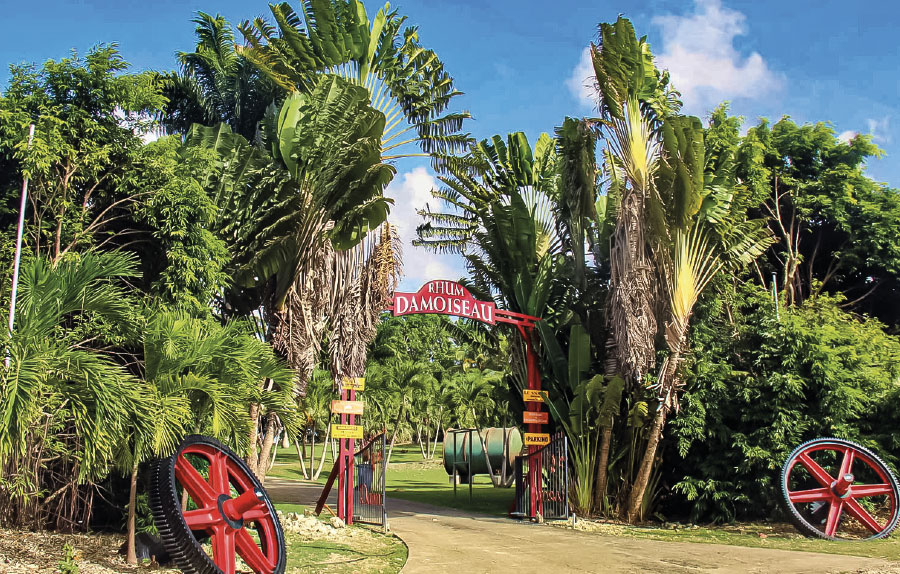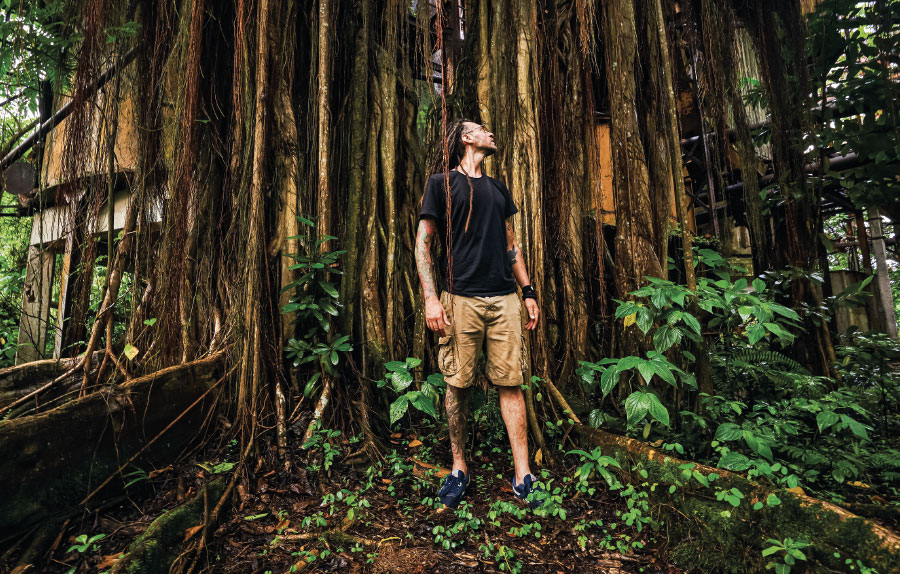We first met Italian bartender Danilo Grenci at the Moonshiner, the temple of speakeasy-style whiskey, then at the Blue Bird, the sixties gin headquarters. His passion for Guadeloupe and rum led him to dress the role of Brand Developer for the family-owned Damoiseau since 2019. His mission: to integrate rhum agricole into the cocktail world. Meeting with a personality guided by the love of good spirits.
Danilo Grenci has recently arrived in Lille at the end of September to host a Damoiseau lesson for the local bartending community. We find the new Brand Developer of this family business, with a smile on his face and a soft voice punctuated by his singing Italian accent, in the cosy setting of the cocktail bar Le Dandy. Let’s go for an hour interview with the new rum man of Guadeloupe.
Laurence Marot: We know your background as a professional sportsman. How did you come to cross the world of cocktails?
Danilo Grenci: I come from a family in the south of Italy, Calabria and Sardinia, two regions renowned for their tasteful cuisine that educated and enriched my palate. I started studying medicine while practicing French boxing at a high level.
The French national boxing team, which was training at INSEP, invited me to a year of training in France. To earn a living, I worked as a bartender and had the chance to work with Scotty Schuder in a festive bar in the Bastille district, equipped with a real cocktail station where you could drink old fashioned.
Compared to France, Italy already had a certain cocktail culture with simple drinks, aperitif cocktails like the americano, the negroni or the Campari soda. For my part, I’ve always had an appetite for the world of gastronomy. I learned to cook with local products in the countries where I traveled such as Laos, Thailand and South Korea, which have a wonderful cocktail scene.
That’s why I use a lot of spices and herbs in my creations. My first job in a real cocktail bar was at Moonshiner in 2013 where I managed the opening alone with Marilou Jampolsky. Pasa Omerasevic, whom I met in a nightclub-restaurant-beach club in Genoa’s coastal resort, and Pedro Martinez joined the squad. We set up the Blue Bird with a gin-focused offer, which didn’t exist much at the time.
You went from being Mr. Gin to Mr. Rum with your victory in the French final of the “Chairman’s Reserve Mai Tai Challenge”. How did this passion for this exotic spirit come about?
In Italy, we have always drunk a lot of rum, especially in cocktails like Cuba Libre. In my region, the Rum Cooler was king in the bars. It was prepared with white rum, aged rum, a wedge of orange, two wedges of lime, sugar and ginger ale. The leading rum brand in the market was the Venezuelan Pampero.
Rum has always had an important place in my life. I come from Genoa, a port city famous in the past for its international trade and commerce. There was a time when my life was punctuated by boxing, working and reading about the production of spirits until the early hours of the morning.
Compared to other spirits, I became aware that the history of rum never ends and that there is something special about this spirit, the diversification and its heavy history. Between a French, Scottish or Japanese whisky, one does not really discern any difference if one does not know whisky.
On the other hand, if you taste an agricole rum from Guadeloupe, a Japanese cane juice rum, or a molasses rum from Barbados, you will discover three distinct profiles, always talking about rum and sugar cane. To get back to your question, I’ve never liked wearing the hat of a particular spirit.
A good bartender must master a full background of knowledge and be prepared for any type of alcohol. I like the rum community because it is simple and straightforward with a need to get back to basics compared to other spirits.
How did you meet Damoiseau?
After leaving Blue Bird, I spent more than a year between consulting and traveling. I realized that I could do things outside the bar, while preserving the same spirit. Thanks to two very famous DJ friends in Guadeloupe, I organized a masterclass for bartenders on the island.
At that time, I visited all the distilleries on the island without saying I was a bartender. I then wrote to all the brands to inform them that I was organizing this event in order to highlight the rums of Guadeloupe. Two distilleries responded favorably, one of which took great care of my request, the Damoiseau house.
I began collaborating with the team in 2018 on the occasion of the Route du Rhum with Guillaume C. Leblanc on events in Saint-Malo. 80% of the bars in the city work with the brand. Note that the next edition will also take place in 2022, the year of the 80th anniversary of the distillery.
What image did you have of Guadeloupe rum compared to Martinique?
I don’t like to make comparisons. Both are equally qualitative. The distilleries in Guadeloupe are owned by families and not by groups like in Martinique.
The PGI Guadeloupe is based on the same basis as the AOC Martinique except for some differences on the distillation columns and the agricultural land used for rum production. It is important to know that sugar cane is the economic engine of Guadeloupe, 70% of which is reserved for sugar.
Its use for rum is the tip of the iceberg of a sector. I first tried Guadeloupe rum in 2005, when I was still in the ring and on a draconian diet, and my palate had not yet grown. It wasn’t like what I was drinking in Italy, I recall.
You are the first Brand Developer of Damoiseau, what is your mission?
We discussed for a long time to determine the profile of my position. Today, my mission is clearly defined: to share the world of Damoiseau with the cocktail world in France and abroad, i.e. its origins, its production methods, its rums… the why and the how.
Unfortunately, agricole rum is not represented at its true value, especially in France, but little by little we are getting there, just like Armagnac and Calvados, pure products of the land, and today we are able to find more and more spirits in supermarkets. It is necessary to know that at the beginning of the Sixties, the rhum agricole was only sold in bulk before being marketed in bottles by the network of great distribution; it is one of the reasons for which rhum agricole is sometimes flanked by a bad image.
Paradoxically, the notoriety of agricole rum is more developed in cocktail bars abroad, which are less afraid to use this spirit in cocktails. They see exoticism and creativity in this category of rum, which is rarely used beyond ti-punch, planteur, or rhum arrangé. The important thing for Damoiseau is to create a cocktail culture around agricole rum.
Damoiseau is a small family business but its presence is very strong on the local market. 
Externally, Geoffrey Chambonniere is the export manager, Clementine Guillot is also in charge of exports and she is an ambassador especially for Italy, Marc-Nicolas Morand is the sales manager and finally, last but not least, Nicolas Legendre is the team manager, a real rum connoisseur who manages all the strings and I am the Brand Developer.
My days are never the same. One day, we stay in the office to think about strategies or new products for the range. Another day, I’m organizing a masterclass for agents or a cocktail party at a bar. Right now, we’re working on several types of “work in progress” rums…
How do you see the future of agricole rum in the cocktail world and how are you working with Damoiseau to appeal to the bartending community?
I am optimistic about the development of agricole rum in cocktail bars. 10 years ago, back bars had 7-8 bottles, all the standards, Jack Daniel’s, Martini Rosso and Bianco, Malibu, Campari, vodka, triple sec, curaçao.
This was enough to make the cocktails that were in vogue at the time. Today, many bars are full of forty whiskies behind their counter and the same goes for rum. With this wider range of products, bartenders are starting to have fun and attract the curiosity of customers.
For example, a classic daiquiri can be made with Cuban rum, but also with Jamaican rum, which gives a certain type of taste, or with Barbados rum for a different flavor profile. With agricolel rum, it’s the bomb!
The more I mature, the more I realize that when I have good products available, the urge to make cocktails with 10 ingredients disappears. I prefer to sublimate only 2-3 good products rather than adding 1000 flavors.
With Damoiseau, I love working with the house’s signature 50% white rum in cocktails. It has a bold texture, a sugar cane edge and floral notes. I often feature a zombie twist made with 55% ABV white Damoiseau mixed with dry, woody Damoiseau Gold, house passion fruit syrup, lemon, pink grapefruit and a little absinthe. I also highlight the toddy made with VO rum, Jamaican allspice liqueur and lime juice.
A simple drink made with good basic products. As a good Italian, I’m also a fan of a simple blend of VO rum with vermouth and orange zest, refreshed with ice. It is splendid. It is true that in Guadeloupe the cocktail culture is not the same. One puts on the table a bottle of rum, lime and different syrups and the turn is played. You can find wonderful local products.



